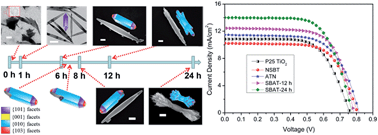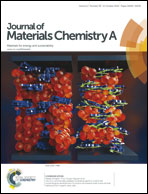Three-dimensional self-branching anatase TiO2 nanorods: morphology control, growth mechanism and dye-sensitized solar cell application†
Abstract
Complex three-dimensional (3D) hierarchical nanostructures based on well-defined low-dimensional nanobranches of different sizes and specific exposed facets are highly desirable to obtain tunable physicochemical properties. Herein, a facile, one-step hydrothermal method is employed to construct self-branching anatase TiO2 (SBAT) 3D hierarchical nanostructures. By simply controlling the reaction time and weight ratio of F127/TBAH, SBAT nanorods can be obtained with a large percentage of exposed {010} facets. Based on X-ray diffraction (XRD), field-emission scanning electron microscopy (FESEM) and transmission electron microscopy (TEM) analysis, a growth mechanism is proposed for the formation of such self-branching 3D nanostructures, which involves the formation of the L-shaped step edges on the [103] surfaces and the alignment of the crystal facets (103) of anatase nanocrystals with the (103) face on the tips of the main anatase TiO2 nanorods. The dye-sensitized solar cell assembled with the SBAT nanorods exhibits an outstanding power conversion efficiency of 7.17%, which is superior to that of the devices based on the 1D anatase TiO2 nanorods and P25 TiO2. This high performance can be attributed to the high dye-uptake density, large size and unique self-branching 3D hierarchical nanostructures built from 1D nanobranches growing epitaxially from the main rod.


 Please wait while we load your content...
Please wait while we load your content...